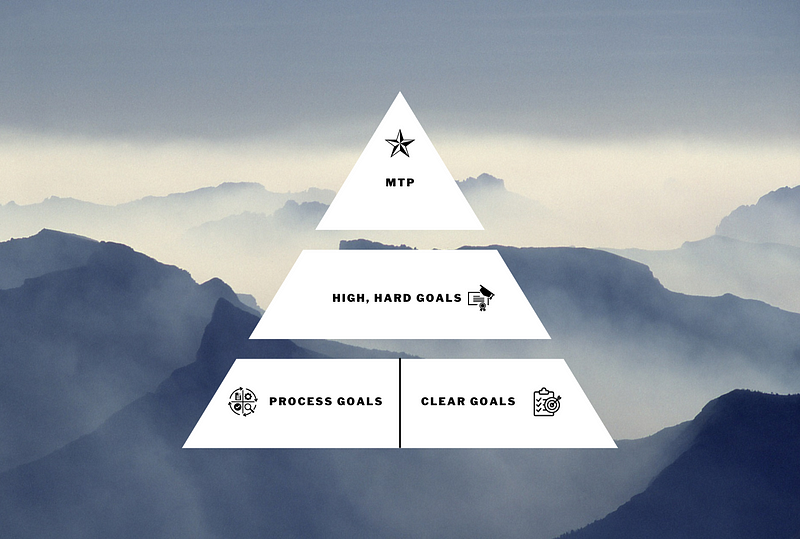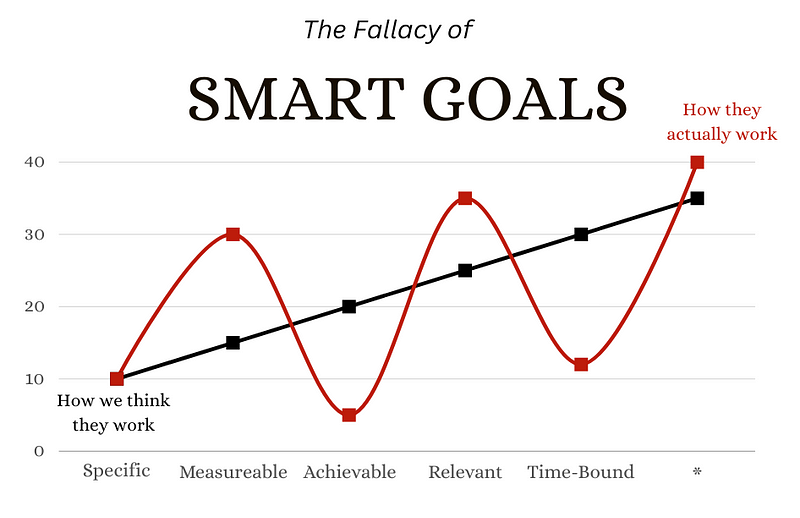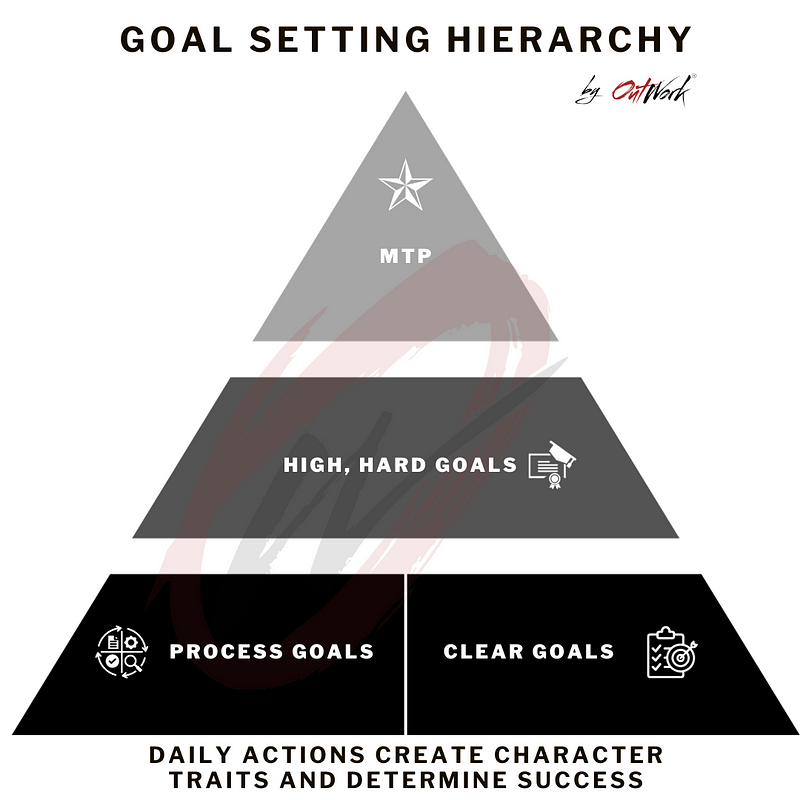The Ultimate Goal-Setting Guide for 2024 and Beyond
The complete process for doing what you said you were going to do

If you’re tired of hearing about “SMART” goals, then you’ve come to the right place.
SMART goals are actually really dumb. They are the remnants of a bygone era and reduce a complex process into a singular entity. Do this one thing and finish at this exact time. Not only is goal setting much more complex, but the actual process of achieving those goals is rarely that linear. Today’s world is much more dynamic. The modern worker has a blend of personal and professional demands of their time. They must handle rapid change at work due to emerging technologies, systems, and processes in addition to their familial obligations and personal aspirations.
A goal is no longer a singular path; it exists in a spectrum of ever-changing and evolving processes.

The ups and downs that come with goal setting are not succinctly captured in the SMART system.
What you do every day is never mentioned. The WHY behind the goal is barely covered. A complete goal-setting system has both high, hard goals and clear, everyday goals. Beyond the outcome, there is also a Massively Transformative Purpose (MTP) that acts as a north star. And most of all, there is a set of process goals that instill the character traits necessary to actually achieve the goal. What SMART gurus don’t know is that the actions you take every day are the true determinants of whether or not you do what you said you were going to do (i.e., accomplish a goal).
Producing an ordered list that concludes with “earn a million dollars in 2024” is as useless as shouting into the wind, “I want to become a millionaire.”
What’s more important is becoming the type of person who is capable of earning a million dollars, in pursuit of a bigger purpose than just the money alone, with clearly identifiable outcomes along the way, guided by a set of daily actions that make you feel good when you do them (a state of flow).
How To Actually Set Goals (And Accomplish Them)
The process of setting a goal is much more complex than it seems because humans are much more complex than ordered lists. Instead, we require a multi-faceted approach to seek out and accomplish the things we aspire to do in life. The information age makes certain things easier but also adds to the complexity and interconnectedness of how we think about goals. The trap of social media comparison, for example, means we are rarely happy with the things we have. Instead, we focus on the things that we don’t have and become obsessed with how inadequate we appear to be.
When considering all of these various factors, the most reliable way to set a goal is to set multiple goals at varying levels.
The various levels take into account our driving purpose (north star) and high, hard goals as the outcomes we seek. Process and clear goals are described as the daily actions we take to achieve them. These are all goals in that we can check them off a list when accomplished, except our MTP, which allows us to play an infinite game. It is so massive and transformative that we are always working towards it.
An MTP, by its very nature, is unachievable.

Massively Transformative Purpose (MTP)
Your MTP is the overarching guiding light for your personal and professional life. Steven Kotler, the flow guru and author who penned the book where I first learned about MTPs, provides an outline for choosing your MTP:
- Massive: it’s large and audacious
- Transformative: it brings significant change to an industry or even the planet.
- Purpose-driven: it sets a vision that gives your life meaning (where you direct your burn and daily actions)
My MTP is a simple statement: break generational curses and build generational wealth. It’s audacious because it spans the generations that have come before me and those that will follow. Building generational wealth, for example, is an undefinable number, where high, hard goals are set for 10, 15, and 20 years out.
Kotler has three MTPs: “Write books that have a deep impact, advance the science and training of flow, and make the world a better place for animals.
His coauthor Peter Diamandis has a similar driving purpose: “To inspire and guide entrepreneurs to create a hopeful, compelling, and abundant future for humanity.”
The thing about an MTP is that you have to revisit it often. It is a guiding light, meaning you should always be moving in that direction. For this purpose, Diamandis also provides instructions on how to activate your MTP:
- Every morning, repeat it aloud several times. This practice reinforces his MTP, his highest calling in life, and adds the necessary fuel to execute daily process and clear goals.
- Use it as a filter for clear goals. As described in more detail later in this post, clear goals are the daily action steps you take to accomplish high, hard goals in pursuit of your MTP. If it doesn’t align with his MTP, he doesn’t do it.
- Finally, Diamandis shares it everywhere. I read about it in their book, but I also saw it here. This is how he gets others to support his MTP. And to build an abundant future for humanity, he will need some help.
Pursuing your MTP is an infinite game, and I love playing.
High, Hard Goals
Usually, when someone is talking about a goal, they are referring to their high, hard goals. High, hard goals, according to Kotler, are bigger goals that act as substeps to reaching your MTP. They also direct your process goals and daily action steps for months and years at a time. Getting a degree of any type is a high, hard goal. Writing a book, starting a podcast, and getting an industry-leading certification are high, hard goals. If your MTP is to end world hunger, a high, hard goal would be to get a Master’s degree in nutrition and spend time overseas learning about governmental organizations that are doing that very thing. They take years to accomplish and are generally pretty hard to do.
Most people confuse high, hard goals with an MTP, but the difference is that when you achieve it, you move on to another high, hard goal.
You can only end world hunger once. You can get several degrees that will help you do it.
Daily Actions
The things you do on a daily basis are the ultimate determinants of success. A high, hard goal doesn’t matter much unless you are constantly working on the things that will get you that outcome. A grandiose MTP, like breaking generational curses, is pointless if I continue to do the things that have always been done.
That is why I spend a disproportionate amount of time talking about process and clear goals. They are the daily actions that lead to the “big” thing you’ve always wanted or have been pursuing.
Process Goals
I’ve adopted the term process goal from the field of sport and performance psychology. From this perspective, process goals focus on the specific actions or behaviors that an individual engages in during performance. Unlike outcome goals, which are concerned with the result (like winning a game), or performance goals, which are focused on achieving a standard (like a personal best), process goals are entirely under the performer’s control.
For a basketball player, a process goal might be to maintain a specific form while shooting. For a musician, it could be to focus on their breathing technique during a performance. What makes process goals so powerful is they are entirely within the athlete’s or performer’s control, regardless of the external environment or competitors. Focusing on the outcome distracts the performer while focusing on the process helps direct their action. It helps them to concentrate on the present moment, reducing anxiety about the final outcome. It leads to more consistent performances, as it emphasizes specific actions and behaviors. They help in honing skills and techniques, leading to overall improvement.
When it comes to setting goals, process-oriented goals are the most powerful.
In my goal-setting hierarchy, they are the routine actions and behaviors that you will perform every single day (or week) in pursuit of your high, hard goals. They help break down big outcome goals into small actions that contribute to the end result. Most importantly, they are essential in shaping the goal-setter into the type of person necessary to accomplish their goals and realize their MTP. It is uncommon for a goal-setting hierarchy to refer to the person responsible for achieving its outcome. It is assumed that the person will just manifest the type of character traits necessary to achieve their goal. Very rarely, if ever, is that the case. You must build the accompanying character traits to achieve high, hard goals.
To end world hunger, you must become the type of person capable of ending world hunger.
A person worthy of greatness, as you can imagine, is capable of doing hard things. They can lead large teams and inspire a vision to the masses. They can work harder and longer than most. They are intrinsically focused, determined, and strong-willed. These traits are built upon months and years of daily actions. These daily actions are directed, deliberate, and processed focus goals.
Process goals are how you become the “who” behind the goal. And hard things require “who,” not “how.”
Clear Goals
Beyond process goals, there is a set of daily actions that come in the form of clear goals. According to Kotler, they are the inverse of a high, hard goal, as in daily substeps required to accomplish them. Kotler refers to them as daily to-do lists, which is what makes them different from process goals. Process goals you do on a rhythm, whereas clear goals change based on what you need to accomplish that day. If a process goal was to read for 30 minutes a day, a clear goal might be to read chapters 1 and 2 of The Art of Impossible. Clear goals, like process goals, require you to chunk down your MTP and high, hard goals into smaller action steps. Clear goals are how you adjust to the demands of a highly engaging life focused on creativity on mastery.
They are a gateway to reflection and help direct the only thing you can truly control: what you can do at this moment.
As a side note, clear goals are flow triggers. When you check one of your lists, it releases a tiny bit of dopamine and norepinephrine, the feel-good chemicals that make you want to keep going.
In The Art of Impossible, I love how Kotler sums up clear goals in pursuit of bigger things: “The big point: Impossible is always a checklist. Do every item on your checklist today, do every item on your checklist tomorrow, and repeat. This is how clear goals become high, hard achievements, which become milestones on the way to massively transformative purposes.”
In summary, to accomplish a goal, you have to build them along a hierarchy:
- Establish your Massively Transformative Purpose and use it as a guiding light for everything you do.
- Establish some high, hard goals that are outcome-based, and directionally pointed at your MTP. These take months and years to accomplish.
- Establish the requisite process goals that will allow you to achieve your high, hard goals while also transforming you into the type of person capable of actually achieving them. Think “who” not “how.”
- Fill in the spaces with clear goals, a daily to-do list that allows you to reflect on your progress and trigger flow.

If you want to build a High-Performance Life subscribe to The High-Performance Daily for a story in your inbox every single day.
Follow me on Instagram, Twitter, and Threads (@outworkchief) for updates, or visit my coaching website at trainoutwork.com. I also provide free fitness and nutrition advice on Twitter by tagging me.
